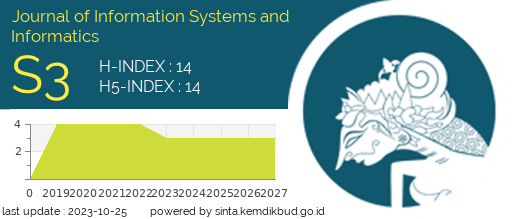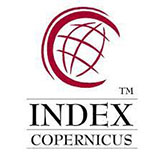Analysis of Factors That Influence the Use of Social Media Analytic Debi Using UTAUT Model
Abstract
Social media has provided consumers with new opportunities to engage in social interactions on the internet. The very high increase in the number of social media users has provided a new market for companies that can be seen as new business opportunities. Digital Brand Index or also called DEBI is a social media Analytic developed by limadigit agency in 2014 which aims to be a unique selling point for the agency. This study aims to determine what factors influence the behavior of using social media Analytic DEBI using the Unified Theory of Acceptance and Use of Technology method (UTAUT). The Conclusion of this study is behavioral intention has a significant effect on use behavior, performance expectancy doesn’t has a significant effect on behavioral intention, effort expectancy doesn’t has a significant effect on behavioral intention, facilitating condition has a significant effect on behavioral intention, information quality doesn’t has a significant effect on behavioral intention, existing features has a significant effect on behavioral intention, based on the conclusion, the factors that influence the use behavior of DEBI are behavioral intention, facilitating condition and existing features.
Downloads
References
E. Noprianto, “Pemanfaatan Media Sosial Dan Penerapan Social Media Analytics (Sma) Untuk Perpustakaan Di Indonesia,” J. Pustaka Budaya, vol. 5, no. 2, pp. 1–10, 2018, doi: 10.31849/pb.v5i2.1583.
A. Moghadamzadeh, P. Ebrahimi, S. Radfard, A. Salamzadeh, and D. Khajeheian, “Investigating the role of customer co-creation behavior on social media platforms in rendering innovative services,” Sustain., vol. 12, no. 17, 2020, doi: 10.3390/SU12176926.
S. H. Liu, C. H. Chou, and H. L. Liao, “An exploratory study of product placement in social media,” Internet Res., vol. 25, no. 2, pp. 300–316, 2015, doi: 10.1108/IntR-12-2013-0267.
S. Zhang, L. Zhao, Y. Lu, and J. Yang, “Do you get tired of socializing? An empirical explanation of discontinuous usage behaviour in social network services,” Inf. Manag., vol. 53, no. 7, pp. 904–914, 2016, doi: 10.1016/j.im.2016.03.006.
M. Rosemann, M. Eggert, M. Voigt, and D. Beverungen, “Leveraging social network data for analytical CRM strategies-the introduction of social BI,” ECIS 2012 - Proc. 20th Eur. Conf. Inf. Syst., 2012.
N. Hajli, “A study of the impact of social media on consumers,” Int. J. Mark. Res., vol. 56, no. 3, pp. 387–404, 2014, doi: 10.2501/IJMR-2014-025.
V. Venkatesh, J. Y. L. Thong, and X. Xu, “Consumer Acceptance and Use of Information Technology: Extending the Unified Theory of Acceptance and Use of Technology,” MIS Quarterly, Vol. 36, No. 1 (March 2012), pp. 157-178, vol. 36, no. 1, pp. 157–178, 2012, doi: 10.1109/MWSYM.2015.7167037.
A. A. Taiwo and A. G. Downe, “The theory of user acceptance and use of technology (UTAUT): A meta-analytic review of empirical findings,” J. Theor. Appl. Inf. Technol., vol. 49, no. 1, pp. 48–58, 2013.
A. Tarhini, M. El-masri, M. Ali, and A. Serrano, “Extending the UTAUT model to understand the customers ’ acceptance and use of internet banking in Lebanon A structural equation modeling approach,” 2016, doi: 10.1108/ITP-02-2014-0034.
D. Afrizal and M. Wallang, “Attitude on intention to use e-government in Indonesia,” Indones. J. Electr. Eng. Comput. Sci., vol. 22, no. 1, pp. 435–441, 2021, doi: 10.11591/ijeecs.v22.i1.pp435-441.
A. Latif, A. Rahman, A. Jamaludin, and Z. Mahmud, “Intention to Use Digital Library based on Modified UTAUT Model: Perspectives of Malaysian Postgraduate Students,” vol. 5, no. 3, pp. 270–276, 2011.
D. Tri Kurniawati, N. H. Rosita, and R. Anggraeni, “The role of emotional marketing and UTAUT on donation intention through social media,” Int. J. Res. Bus. Soc. Sci. (2147- 4478), vol. 10, no. 1, pp. 38–46, 2021, doi: 10.20525/ijrbs.v10i1.1026.
A. M. Berry, “Behavioral intention and use behavior of social networking websites among senior adults.,” Diss. Abstr. Int. Sect. B Sci. Eng., vol. 79, no. 7-B(E), p. No-Specified, 2018, [Online]. Available: https://nsuworks.nova.edu/gscis_etd%0Ahttp://ovidsp.ovid.com/ovidweb.cgi?T=JS&PAGE=reference&D=psyc16&NEWS=N&AN=2018-21182-280.
M. A. Arenas-Gaitán, Jorge Ramón-Jerónimo and Begoña Peral-Peral, “Elderly and Internet Banking: An Application of UTAUT2,” J. Internet Bank. Commer., vol. 18, no. 2–11, p. 10, 2015, [Online]. Available: http://eprints.utm.my/8136/.
H. Khechine and M. Augier, “Adoption of a social learning platform in higher education: An extended UTAUT model implementation,” Proc. Annu. Hawaii Int. Conf. Syst. Sci., vol. 2019-Janua, pp. 53–62, 2019, doi: 10.24251/hicss.2019.008.
D. Hamidah, Siti; Anita, “Analisis Persepsi Citra Merek, Desain, Fitur Dan Pengaruhnya Terhadap Keputusan Pembelian Produk Handphone Samsung Berbasis Android (Studi Kasus Stie Pelita Indonesia),” Igarss 2014, vol. 21, pp. 1–20, 2013.
 Abstract views: 2450 times
Abstract views: 2450 times Download PDF: 1807 times
Download PDF: 1807 times
- I certify that I have read, understand and agreed to the Journal of Information Systems and Informatics (Journal-ISI) submission guidelines, policies and submission declaration. Submission already using the provided template.
- I certify that all authors have approved the publication of this and there is no conflict of interest.
- I confirm that the manuscript is the authors' original work and the manuscript has not received prior publication and is not under consideration for publication elsewhere and has not been previously published.
- I confirm that all authors listed on the title page have contributed significantly to the work, have read the manuscript, attest to the validity and legitimacy of the data and its interpretation, and agree to its submission.
- I confirm that the paper now submitted is not copied or plagiarized version of some other published work.
- I declare that I shall not submit the paper for publication in any other Journal or Magazine till the decision is made by journal editors.
- If the paper is finally accepted by the journal for publication, I confirm that I will either publish the paper immediately or withdraw it according to withdrawal policies
- I Agree that the paper published by this journal, I transfer copyright or assign exclusive rights to the publisher (including commercial rights)






















_1.png)












